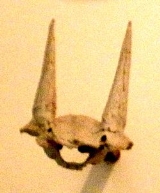
Eotragus
Encyclopedia
Eotragus is an early bovid
from Europe
, Africa
, and Asia
during the Miocene
some 20-18 million years ago. It is related to the modern Nilgai
and Four-horned Antelope
. It was small and probably lived in woodland environments.
Bovid
A bovid is any of almost 140 species of cloven-hoofed ruminant mammal at least the males of which bear characteristic unbranching horns covered in a permanent sheath of keratin....
from Europe
Europe
Europe is, by convention, one of the world's seven continents. Comprising the westernmost peninsula of Eurasia, Europe is generally 'divided' from Asia to its east by the watershed divides of the Ural and Caucasus Mountains, the Ural River, the Caspian and Black Seas, and the waterways connecting...
, Africa
Africa
Africa is the world's second largest and second most populous continent, after Asia. At about 30.2 million km² including adjacent islands, it covers 6% of the Earth's total surface area and 20.4% of the total land area...
, and Asia
Asia
Asia is the world's largest and most populous continent, located primarily in the eastern and northern hemispheres. It covers 8.7% of the Earth's total surface area and with approximately 3.879 billion people, it hosts 60% of the world's current human population...
during the Miocene
Miocene
The Miocene is a geological epoch of the Neogene Period and extends from about . The Miocene was named by Sir Charles Lyell. Its name comes from the Greek words and and means "less recent" because it has 18% fewer modern sea invertebrates than the Pliocene. The Miocene follows the Oligocene...
some 20-18 million years ago. It is related to the modern Nilgai
Nilgai
The nilgai , sometimes called nilgau, is an antelope, and is one of the most commonly seen wild animals of central and northern India and eastern Pakistan; it is also present in parts of southern Nepal. The mature males appear ox-like and are also known as blue bulls...
and Four-horned Antelope
Four-horned Antelope
The Four-horned Antelope , or Chousingha, is a small antelope found in open forest in India and Nepal. It is the only species currently classified in the genus Tetracerus.-Description:...
. It was small and probably lived in woodland environments.

